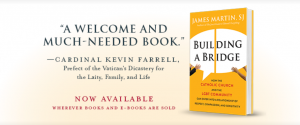By Cat Swindal

On the day after the one year anniversary of the horrific shooting at the Pulse nightclub in Orlando, where 49 people lost their lives, James (Jim) Martin, S.J., released a book called “Building a Bridge: How The Catholic Church And The LGBT Community Can Enter Into A Relationship Of Respect, Compassion, And Sensitivity.”
This book was aimed to answer the question posed in the title: how these two communities can see and love each other with respect, compassion and sensitivity on both sides. Despite its publication in June, the book has garnered a lot of attention recently, especially on social media. I’ve been wanting to take the opportunity to express my disagreements with the book.
I especially want to make clear that I am speaking solely from my own experience and struggles as a queer Catholic, as it has been a constant internal struggle for me to hold these two identities.
This goes without saying, but it hurts me spiritually that I cannot marry my girlfriend in the church that I grew up in, the church that has nurtured who I am as a person. It is hard to have heard stories from my LGBT friends being told by Catholic priests that they were going to Hell for being who they are. So when I bought this book, I was excited, since not only is Jim Martin one of my favorite priests, but he was writing a book about the bridging of two identities that I hold dear. I was hopeful to get some answers.
Unfortunately, I do not feel the book accomplishes enough to create the “two-way bridge” Martin desperately wants, as he is insensitive in some respects towards a topic that must be handled with a lot of careful sensitivity.
The first issue at hand: the length. Martin attempts to raise and solve a problem of such great multitude, a problem which has been plaguing LGBT Catholics for centuries, in a grand total of 76 pages. I see 76 pages, and I see simplicity. The relationship between the LGBT community and the Catholic church deserves more. It is in no way an issue that can begin to be solved in less than 100 pages.
In the beginning of the book, though Martin tries to be as sensitive as possible, he does not accurately include all of the acronyms that describe the LGBT community. On page 10 of his book, Martin gives four acronyms: LGBT, LGBTQ, LGBT+ and LGBTQA. In his book, he uses LGBT for shorthand, as I do in this article.
However, in this section on labeling, he does not include the acronym I have found to be most inclusive: LGBTQIA+, which stands for Lesbian, Gay, Bisexual, Trans, Queer/Questioning, Intersex and Asexual. Martin leaves the identities Intersex and Asexual out of the picture completely, and writes that allies are a part of the LGBTQA acronym.
Though some people do include allies in the acronym, Martin is being less inclusive than he wants to be by leaving out two important identities, although he wants to “include all people who may feel that their spiritual journey and their welcome in the church have been made more difficult by their sexual orientation.” Of course, I am grateful he does not call the LGBT community “homosexual persons” as past church leaders have done. But, by leaving intersex and asexual people out, Martin is not being as inclusive as he wants to be.
Martin also makes biblical references that I feel are not sensitive to the LGBT community. In his chapter on how the Church should respond with sensitivity to LGBT people, Martin refers to the story of Jesus dining with Zacchaeus, the fraudulent tax collector.
After dinner, Zaccheus changes his ways. This is what Martin offers for the Church to build a relationship with the LGBT community: “community first — meeting, encountering, including — and conversion second.” In context, Martin is writing about those in the Church who will not meet the LGBT community halfway because in their view the community has “sinned,” and instead the Church should reach out to them.
However, I am insulted that he implies a comparison of a tax collector to the LGBT community. Tax collectors in biblical times could change their ways, but I cannot change who I am, no matter how nice and “inclusive” the Church may be to me. To think that some church leaders could read this book and hope that to be nice to members of the LGBT community would lead to their, what Martin labels as, “conversion,” makes me sick to my stomach, and would honestly make me question the motives of several Church leaders.
To that end, I disagree with Martin’s use of personal anecdote to sympathize with the LGBT community in an argument to give the Church “the gift of time.” In such an anecdote, Martin writes about how difficult it was to tell his parents that he wanted to be a Jesuit. They were angry at first but later accepted him and his vocation. He used this anecdote to say that LGBT people should give the Church more time and more patience to finally come around.
This is yet another comparison Martin implies that insults me. Again, I cannot leave the identity I have, but if Martin was called to leave his vocation, although a difficult process, he could leave. I have personal qualms with this because my dad, who was a Jesuit, left because his vocation called him to get married and have children.
The relationship Martin has with his parents should hold no comparison to the relationship between the Church and the LGBT community. For Martin to compare such to his vocation as a Jesuit to me was an overstepping of bounds.
Additionally, “the gift of time” should not be the answer when there are LGBT people who have been humiliated, insulted, and have even died due to the institution’s teaching.
I am lucky enough to be able to develop my spirituality and my faith along with my sexual identity, but others have not had any opportunity to do so , or furthermore are afraid to. While Martin’s parents eventually accepted him, there are those in the Church who do not know me yet will never accept who I am, no matter how much time I give them.
This does not mean to say that I don’t admire what Jim Martin is trying to do here. Martin is a public figure, a popular one among Catholic youth and elders alike. For such a high-profile priest to tackle a sensitive and important issue such as this deserves high praise, and I truly admire him for taking the time to write about it. I admired how at the end of his book, he provides mediations for the LGBT community, for queer spirituality is definitely of importance.
I also feel for him as he is continually being attacked on the Internet and in real life by people who, to put it nicely, strongly disagree with him. To publish a book on this topic is no easy task and is not without consequence, and he is taking such on. I walk with him for having this hatred be put on his shoulders.
However, I am taking the opportunity to write about my disagreements with this book because queer Catholics often do not have a voice in the Church. In this article, I hope to have shown my more left-leaning ally friends who may like Jim Martin how his book is far from perfect, and should not be the end of the conversation between the Church and the LGBT community.
Perhaps Martin’s voice is the beginning of such instead. This book should be a welcoming to listen to more LGBT Catholics and what they have to say about their own faith and identity, along with how the Church should move forward.




































































































































































































